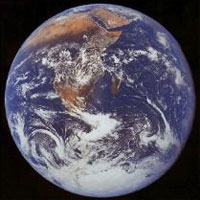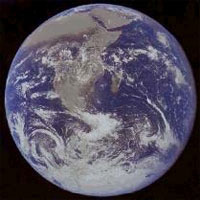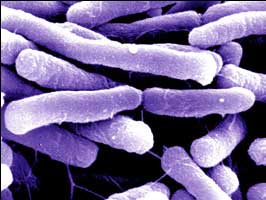| Posted: Dec 21, 2007 | |
Grey goo |
|
| (Nanowerk Spotlight) One of the more interesting concerns of nanotechnology is 'grey goo.' The term was invented by Eric Drexler to describe one of the dangerous issues that must be faced as nanotechnology capabilities evolve. Here’s how it works. 1. Pretend that nanotechnology truly exists to the point where we can fabricate machines of arbitrary complexity using individual atoms or molecules. 2. Pretend that these machines have sufficient complexity and computational means that they can make copies of themselves using whatever happens to be lying within their reach. 3. Pretend that their fabrication systems are such that they can make a copy of themselves about once an hour. 4. Pretend that one of these machines decides to do nothing except make copies of itself. | |
| THEN we take this | |
 |
|
| And turn it into this in about 1 week. | |
 |
|
| It’s a bit worse than the Borg. The idea is that everything gets converted into grey goo: you, me, trees, chickens, and everything. This would not be good news. It would totally ruin my retirement plans. | |
| By comparison, let’s think a bit about my favorite bacterium, e. coli. This bacterium lives in your stomach and mine, and is about 10 micrometers in width, and can make a copy of itself in about 20 minutes. If just one e. coli decided to replicate itself uncontrollably, it could perform the same feat as our hypothetical nanomachine in about a day and a half. | |
 |
|
| Because of this concern, there are those in the nanotechnology community who have proposed legislation that would make it illegal to create a nanomachine with the ability to make a copy of itself. One wonders if we should advocate similar legislation for bacteria. | |
| I am, for some reason, reminded of Indiana House Bill #246 submitted in 1897 which would have made the legal value of Π (pi) = 3.2 The interesting issue here is that e. coli long since made the genetic decision to make as many copies of itself as fast as possible forever and ever and ever. Just counting the bacteria that live inside humans, there are about 3.9 x 1023 (39,000,000,000,000,000,000,000) bacteria that have made that same genetic decision. If we move into the rest of the world, the number of bacteria that have made similar decisions is estimated to be 5 x 1030. So how come these bacteria haven’t converted the planet into sludge? Well, there are two leading answers. | |
| The first is that bacteria dine on each other, so since everyone is having lunch at the same time, no single bacteria has an opportunity to grow at an unrestricted rate without becoming lunch for another bacteria. The grey goo model suggests in this case, that since evolution hasn’t created our runaway nanomachine, there are no natural predators to stop it, so it will convert the planet into copies of itself in about a week. | |
| The second one is that, fundamentally, the universe is a hostile place, and no matter what your intentions, be they lofty or bacterial, the universe just doesn’t provide you with all the parts you need to make things on demand. In fact, if you’re in the mood to make a lot of copies of yourself, the raw materials in your neighborhood are going to get consumed rather quickly, which is going to slow down your rate of replication. Similarly, if you happen to need some rare substance in your replication process, such as tantalum, you’re not going to find very much of it floating around waiting to be consumed. | |
| Thus, while grey goo is certainly an interesting idea and legislation will be pending to see to it that we don’t make it outside of Iraq, there are likely to be some significant natural laws that should bring the threat level down to a manageable level. | |
| On the other hand, we need not worry too much, for the nanotechnology community has proposed that along with grey goo, we should also fabricate blue goo. Blue goo would be the nanocops of this new age, nanomachines that have the express purpose of hunting down and destroying grey goo. The one caveat to all of this is that the military potential of the various kinds of goo will certainly result in some level of funding over the next few decades. In fact, a larger version of goo technology has already been funded by DARPA under the name "smartdust" Perhaps it isn’t such a bad idea to legislate the value of Π... | |
| By Glenn Fishbine | |
|
Become a Spotlight guest author! Join our large and growing group of guest contributors. Have you just published a scientific paper or have other exciting developments to share with the nanotechnology community? Here is how to publish on nanowerk.com. |
|
